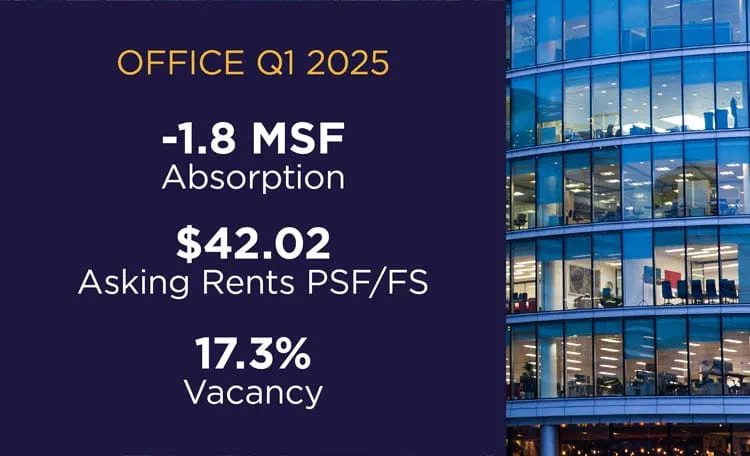Office Market Vacancy Continued to Stabilize in Q1 2025
In its March 2025 Labour Force Survey, Statistics Canada reported that after seven consecutive months of job growth employment fell by 33,000 from last month with the unemployment rate increasing by 10 basis points (bps) from February 2025 to 6.7%. More than likely current economic challenges, driven in part by recent trade disruptions, will impact the labour market through the remainder of the year.
Overall office vacancy was 17.3% in Q1 2025, unchanged from last quarter, as vacancy in both the Central and Suburban markets, and across most classes of space, witnessed only minor fluctuations in vacancy (i.e. 10 to 20 bps) from the previous quarter. The largest increase in vacancy quarter-over-quarter (QOQ) was in the Central Class A market with vacancy bumping up by 40 bps, the steepest quarterly increase since the beginning of 2023, as most of the major markets in Canada witnessed increases in vacancy. One of the exceptions to this was Calgary as that market’s vacancy rate decreased QOQ; not only in Class A assets, but Class B and C as well, in large part driven by ongoing office building conversions removing a sizable amount of vacant space from the market. Despite the overall Canadian Central Class A vacancy rate edging up in Q1 2025, it is likely market conditions will at the minimum stabilize, if not improve, as the year continues as occupiers who are in search of space are continuing to prioritize high-quality, well-located assets.
As the overall vacancy rate remained stable from last quarter, overall vacant space was also little changed. While direct vacancy climbed by approximately 813k square feet (sf), there was the removal of close to 700k sf of sublet vacancy, the seventh straight quarter of decline. This quarter the removal of sublet vacancy was focused within the Suburban Class A market. With only minimal amounts of sublet vacancy in this market segment with original leases set to expire by the end of Q4 2024, the remaining vacant sublet square footage was either leased or removed from the market for other reasons including tenants deciding to keep the space. With an additional 665k sf of sublet vacancy with terms set to expire by year-end 2025, it is anticipated sublet vacancy as a percentage of overall vacancy will continue to decline through the remainder of the year.

The overall office market remained in negative absorption territory this quarter at close to 1.8 million square feet (msf) and was witnessed in both the Central and Suburban markets, across all asset classes. The Central Class A market had the most substantial softening from the previous quarter at negative 780k sf. It is important to note however that this overall negative absorption total was not the result of multiple markets struggling with new vacancy outpacing demand. Vancouver and Calgary had overall positive absorption and in Toronto, while absorption was negative, only contributed a minor amount. Instead, it was the continued softening in the Montreal office market that was the driving factor behind the overall Canadian negative absorption total this quarter, contributing just shy of negative 1.5 msf.
Overall new leasing activity has maintained its momentum and surpassed last quarter’s totals reaching close to 7.6 msf. Leasing velocity was the strongest in the Central Class A market this quarter, representing approximately 37% of the overall total. For the new leases where deal terms were disclosed, the average term continues to be five years and has remained consistently around that term length since 2021. One slight difference is that leases in Class A assets are slightly longer, averaging six years, in both the Central and Suburban markets.
Similar to last quarter, new supply deliveries in Q1 2025 were minimal at 225k sf, consisting of two projects located in the Vancouver Central Class A market. The past six months appear to have been a momentary lull as close to 2.2 msf is set to be delivered next quarter; a key project being 141 Bay Street located in Downtown Toronto which is approximately 1.4 msf. By the end of 2025 an additional 3.3 msf of new supply is forecasted to be completed. Currently there is not expected to be an immediate impact on vacancy as approximately 70% of the overall total square footage is preleased and positive absorption will be generated as tenants move into their new premises. However, as existing spaces are vacated and arrive on the market this may impact both vacancy and absorption levels through the remainder of the year.
The overall average asking net rent increased slightly in Q1 2025 to reach $22.50 per square foot (psf), as most major Canadian markets reporting increases from last quarter. With stable net rates in almost all other submarkets and asset classes it was an increase in the Central Class A asking average net rate which propelled the overage average upwards. The overall gross asking rate in Canada reached $42.02 psf, as the taxes and operating component of the gross rent climbed from last quarter; to be expected given it is a new year, and landlords are generally facing higher costs to operate their buildings.





